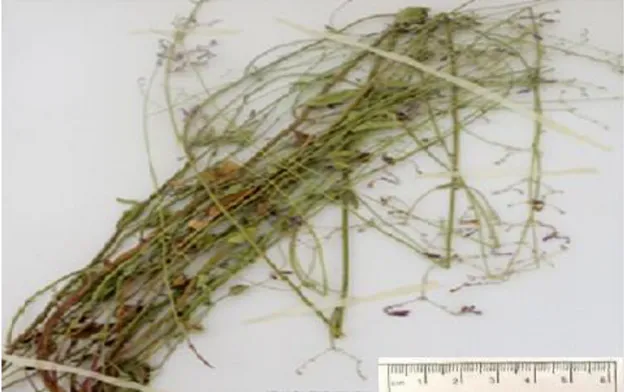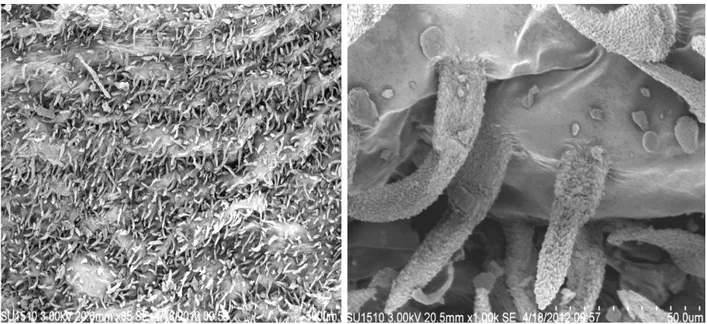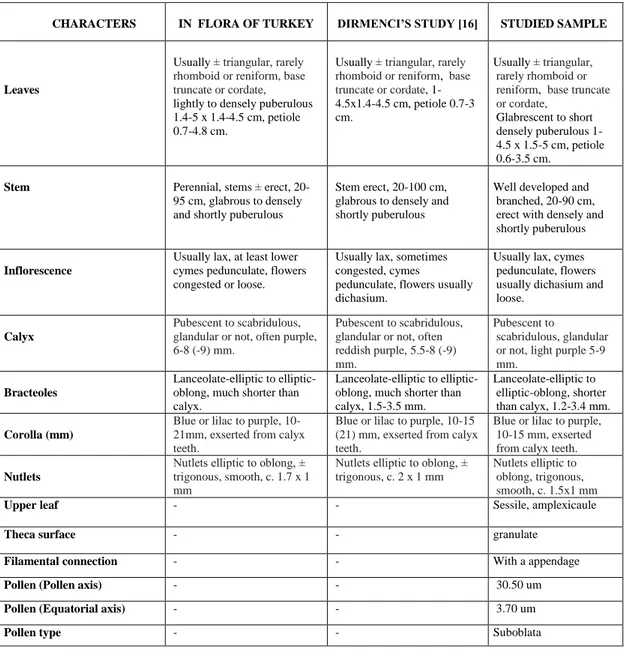Araştırma Makalesi/Research Article
A Morphological Study on Nepeta fissa C.A.Mey. (Lamiaceae)
from Bingöl (Turkey)
Ömer KILIÇ
1Abstract- In this study morphological characters of Nepeta fissa C.A.Mey. investigated for the systematic purposes. At the end of the morphological studies by stereo microscope; leaf shape, leaf indumentum, calyx, corolla, gynoecium, androecium, connection of the filaments to theca and seed characters were determined and compared with Flora of Turkey and Dirmenci’s study with N. fissa. In addition, stem and leaf indumentum, pollen characters and seed coat surface of N. fissa was examined by SEM. Studied sample has shown some variations from Dirmenci’s and Flora of Turkey sample in respect to some characters which are shown in Table 1. As a result, with this study new morphological characters for diagnostic purposes have detected and the description of N. fissa have extended.
Key words-Nepeta, morphology, systematic, Taxonomy.
I.INTRODUCTION
The genus Nepeta L. (Lamiaceae) rarely annual, perennial and often pleasantly aromatic herbs mostly found in temperate Europe, Asia, tropical Africa and contains approximately 250 taxa in the world [1]. Nepeta represented in Turkey by 40 taxa, 16 of them are endemic (endemism rate ca. 40%) [2-4]. In Turkey Nepeta taxa divided into 2 groups: Mediterranean (13 taxa) and Irano-Turanian (21 taxa). The Irano-Turanian taxa are mainly found in the central, south-east and east Anatolia, whereas the Mediterraneae taxa are growing mainly in the Mediteranean, Marmara and Aegean regions. The other species of Nepeta are widely spreaded throughout Turkey. Some of endemic species of Nepeta are very local and endangered [5]. The stems of Nepeta taxa are generally erect or procumbent; eglandular or glandular; external nutlet characters and anatomical examination of the pericarp might well yield useful characters in the Nepeta taxa [6-7]. Many of Nepeta species are often pleasantly aromatic, rich in essential oils, and of potential economic interest. Several Nepeta species are used in folk medicine as diuretic, diaphoretic, antitussive, antispasmodic, antiasthmatic, febrifuge, emmenagogue, and sedative agents [8,9]. In addition, many researchs on phytochemical analysis of these genus, including essential oil analysis are found in the lirerature [10, 11].
Nepeta have not recognised any sections but have placed the species in three informal groups (designated A, B and C) based largely on flower colour and inflorescence characters in Flora of Turkey. Group A (consists of 14 species): flowers white, yellow or pinkish, nutlets tuberculate throughout or at apex; group B (consists of 16 species): flowers lilac or deep blue, nutlets tuberculate or smooth; and group C (Sect. Oxynepeta Benth., consists of 3 species): flowers white, lilac or purple, nutlets tuberculate, ± spherical [2]. N. fissa is in the group B. Many morphological characters in Nepeta taxa are variable; such as indumentum, leaf shape and size, calyx and corolla characters [12]. So, diagnostic use of such properties above the species level is problematic. Nutlets are good characters for recognition to Nepeta species [13].
In recent times the significance of scanning electron microscopy (SEM) in the study of nutlet surfaces and the taxonomic value of nutlet characters has been explained in many genera of the Lamiaceae [7, 14]. Nutlet morphology in the Labiatae family has proved useful to varying degrees at different levels of the taxonomic hierarchy [7] and the importance of the morphology of nutlet surfaces has already been demonstrated for Nepeta taxa [14,15]. In this study,SEM and stereo microscop was used to determine the micromorphology of N. fissa from Bingol (Turkey) province, both to improve the present knowledge of the studied sample and to evaluate the usefulness of this characters for systematic purposes.
stored in the Bingol University Herbarium (Herbarium no: 2918). The taxonomic description of the plant sample was made according to Davis (1982) [2]and all measurements were made directly on herbarium specimens. Morphological properties of plant sample and measurements and optical observations were carried out under a stereomicroscope wild M5. In addition, the pollen characters, stem indumentum, leaf indumentum and seed coat surface of plant sample was examined with a Hitachi SU-1500 scanning electron microscope (SEM). Dry mature nutlets, stem part, leaf part and stamen (which were shreded to get polen) were mounted directly on stubs, using single adhesive tape, and coated with gold in Wilfrid Laurier University (Canada) Herbarium (Biology).
III.RESULT AND DISCUSSION A. Morphological Properties
Systematic specifications of N. fissa C.A.Mey.
Perennial; stems ± erect, 20-95 cm, glabrous to densely and shortly puberulous. Leaves usually ± triangular, rarely rhomboid or reniform, 1.4-5 x 1.4-4.5 cm, base truncate or cordate, rarely cuneate crenate to coarsely dentate, lightly to densely puberulous; petiole 0.7-4.8 cm. Inflorescence usually lax, at least lower cymes pedunculate, flowers congested or loose. Bracteoles lanceolate-elliptic to elliptic-oblong, much shorter than calyx. Calyx ± tubular, ± straight, 6-8 (-9) mm, mouth oblique, teeth acuminate or blunt, ovate-oblong to triangular, much shorter than tube, lower lip deeply cleft, ± pubescent to scabridulous, glandular or not, often purple. Corolla blue or lilac to purple, 10-21 mm, exserted from calyx teeth. Nutlets elliptic to oblong, ± trigonous, smooth, c. 1.7 x 1 mm. Fl. 6-9. Volcanic and
serpentine rocks, screes, slopes, stepe, dry or moist banks, (540-) 100-1950 m.
Figure 1. General view of N. fissa.
1) Stem
Figure 2. SEM photomicrographs stem of N. fissa
2) Leaves
N. fissa has ± triangular, rarely rhomboid or reniform, 1-4.5 x 1.4-4.5 cm., leaves. The leaf basis of plant sample is cordate and the margins are crenate, all leaves petiolate and petiole 0.7-3 cm. Indumentum of N. fissa leaves are glabrescent to short densely puberulous and densely hairs.
Figure 4. Leaf indumentum of N. fissa (SEM). i. Inflorescence
Flowers of plant sample is born in verticillaster. Inflorescence of N. fissa usually scarcely, chymes pedunculate, flowers usually dichasium. N. fissa has lanceolate-elliptic to elliptic-oblong bracteoles and calyx tubular approximately 5-9 mm length. Mouth of flower is oblique, corolla colour of N. fissa lilac or blue to purple. Corolla lenght of N. fissa is 10-15 mm.
ii. Seed and Pollen
Nutlets of N. fissa is elliptic to oblong, trigonous, smooth, c. 1.5x1 mm. Nutlets colour is blachish-brown.
Pollen type of N. fissa was found suboblata and pollen surface was determined reticulate.
a b
c d
Figure 6. N. fissa, a-b) seed, c) pollen, d) pollen surface.
N. fissa was investigated morphologically in order to assist in identification of this species. The results obtained from morphological studies were generally consistent with the description given in Flora of Turkey [2].
Corolla and nutlets characters are among the important characters in the identification of Nepeta taxa. Our sample has shown some variations from Dirmenci‟s and Flora of Turkey samples in respect to some characters. These variations and more detailed comparison of species are shown in Table 1.
Jamzad et al. (2000) investigated the nutlet surface of the annual species of Nepeta from Iran and in the event Nepeta species are divided into 2 sections: Micrantheae, nutlet surface coarsely tuberculate to finely granular, and Micronepeta, nutlet surface smooth. In this study the nutlet surface of N. fissa was found to be smooth. The pistil colour of studied sample was purplish and about 8 mm. The pollen characters of studied (Table 1).
In conclusion, with this study, new morphological properties for diagnosic purposes of N. fissa have detected and the description of studied sample have enlarged.
Table 1. Morphological characters of N. fissa samples
REFERENCES [1] Mabberley D.J., The Plant Book, Cambridge University Press, 1997.
[2] Davis P.H., Flora of Turkey and East Aegean Islands, University Press, Edinburgh: 7, 1982.
[3] Ozhatay N., and Kultur Ş., “Check-list of add. taxa to the supp. Flora of Turkey III,” Turk. J. Bot., vol. 30, pp. 281-316, 2006.
[4] Ozhatay N., Kultur Ş., and Aslan S., “Check-list of additional taxa to the supp. Flora of Turkey IV,” Turk. J. Bot., vol. 33, pp. 191-226, 2009.
[5] Dirmenci T., Yıldız B., and Tümen G. Threatened Categories of Four Nepeta L. (Lamiaceae) Species Endemic to the East Anatolia. Turk J Bot., vol. 28, pp. 221-226, 2004.
[6] Guner A., Ozhatay N., Ekim T., and Baser KHC., Nepeta L. in: Guner A (ed), Flora of Turkey and East Aegean Islands., vol. 11, 2000.
[7] Aytac Z., and Yıldız G., “A new record for the Flora of Turkey,” Turk. J. Bot.,vol. 20, pp. 385-386, 1996.
[8] Budantsev AL., and Lobova TA., “Fruit morphology, anatomy and taxonomy of Tribe Nepeteae (Labiatae),” Edinburgh J. Bot., vol. 54, pp. 183-216, 1997.
CHARACTERS
IN FLORA OF TURKEY DIRMENCI’S STUDY [16] STUDIED SAMPLE
Leaves
Usually ± triangular, rarely
rhomboid or reniform, base truncate or cordate, lightly to densely puberulous 1.4-5 x 1.4-4.5 cm, petiole 0.7-4.8 cm.
Usually ± triangular, rarely
rhomboid or reniform, base truncate or cordate, 1-4.5x1.4-4.5 cm, petiole 0.7-3 cm.
Usually ± triangular,
rarely rhomboid or reniform, base truncate or cordate, Glabrescent to short densely puberulous 1-4.5 x 1.5-5 cm, petiole 0.6-3.5 cm.
Stem Perennial, stems ± erect,
20-95 cm, glabrous to densely and shortly puberulous
Stem erect, 20-100 cm, glabrous to densely and shortly puberulous
Well developed and branched, 20-90 cm, erect with densely and shortly puberulous
Inflorescence
Usually lax, at least lower cymes pedunculate, flowers congested or loose.
Usually lax, sometimes congested, cymes
pedunculate, flowers usually dichasium.
Usually lax, cymes pedunculate, flowers usually dichasium and loose.
Calyx
Pubescent to scabridulous, glandular or not, often purple, 6-8 (-9) mm.
Pubescent to scabridulous, glandular or not, often reddish purple, 5.5-8 (-9) mm.
Pubescent to
scabridulous, glandular or not, light purple 5-9 mm.
Bracteoles
Lanceolate-elliptic to elliptic-oblong, much shorter than calyx.
Lanceolate-elliptic to elliptic-oblong, much shorter than calyx, 1.5-3.5 mm.
Lanceolate-elliptic to elliptic-oblong, shorter than calyx, 1.2-3.4 mm.
Corolla (mm)
Blue or lilac to purple, 10-21mm, exserted from calyx teeth.
Blue or lilac to purple, 10-15 (21) mm, exserted from calyx teeth.
Blue or lilac to purple, 10-15 mm, exserted from calyx teeth. Nutlets
Nutlets elliptic to oblong, ± trigonous, smooth, c. 1.7 x 1 mm
Nutlets elliptic to oblong, ± trigonous, c. 2 x 1 mm
Nutlets elliptic to oblong, trigonous, smooth, c. 1.5x1 mm
Upper leaf - - Sessile, amplexicaule
Theca surface - - granulate
Filamental connection - - With a appendage
Pollen (Pollen axis) - - 30.50 um
Pollen (Equatorial axis) - - 3.70 um
[9] Tzakou O., Haruda C., Galati EM., and Sanogo R., “Essential Oil Composition of Nepeta argolica Bory et Chaub. subsp. argolica subsp. argolica,” Flavour Fragr J., vol. 32, pp.115-118, 2000.
[10] Rapisarda A., Galati EM., Tzakou O., Flores M., and Miceli N., “Nepeta sibthorpii Betham (Lamiaceae): Micromorphological analysis of leaves and flowers,” Farmaco., vol. 56, pp. 413-415, 2001.
[11] Kilic O., Hayta S., and Bagci E., “Chemical Composition of Essential Oil of Nepeta nuda L. subsp. nuda (Lamiaceae) from Turkey,” Asian J. of Chem.,vol. 6, pp. 2788-2790, 2011.
[12] Kilic, O., Behcet L., and E. Bagci., “Essential oil compounds of three Nepeta L. Taxa From Turkey, and Their Chemotaxonomy,” Asian J. of Chem., 25 (14), pp. 8181-8183, 2013.
[13] Hedge IC., and Lamond J., “Studies in the Flora of Afghanistan: VII, Labiatae Lam.,” Notes Roy. Bot. Gard.,vol. 28, pp. 97-123, 1968.
[14] Jamzad, Z., Harley, MM., Ingrouille, M., Simmonds, MSJ., and A. Jalili A., „Pollen exine and nutlet surface morphology of the annual species of Nepeta L. (Lamiaceae) in Iran. - In: Harley MM, Morton GM & Blackmore S (eds.), Pollen and Spores: Morphology and Biology, pp. 385-397, 2000.
[15] Mosquero, MAM., Juan, R., Pastor, JE., Morphological and anatomical studies on nutlets of Nepeta L. (Lamiaceae) from South-West Spain. Acta Bot Malacitana., vol. 27, pp.15-26, 2002.


